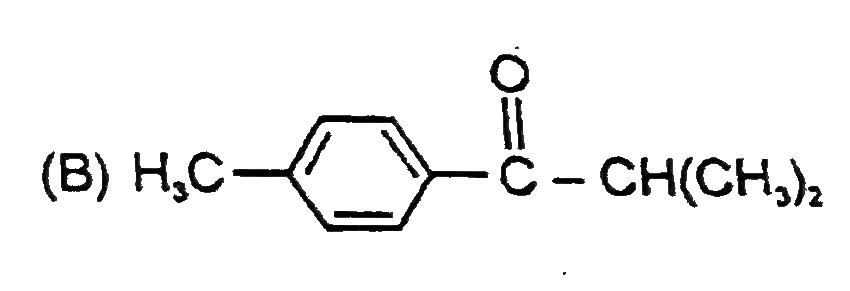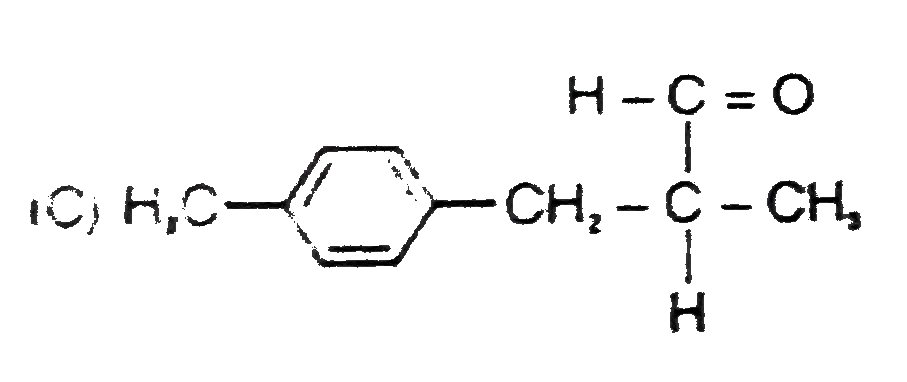Which of these carbonyl compounds on reduction with Zn-Hg/HCl will give the same compound as product




The correct Answer is:A,B,C
To solve the problem of which carbonyl compounds will yield the same product upon reduction with Zn-Hg/HCl, we can follow these steps:
Step 1: Identify the Carbonyl Compounds
We have four carbonyl compounds to analyze. Let's denote them as:
- Compound A: HC=O (an aldehyde)
- Compound B: C6H5C(=O)CH(CH3)2 (a ketone)
- Compound C: C6H5C(=O)H (another aldehyde)
- Compound D: C6H5C(=O)C(CH3)3 (a different ketone)
Step 2: Understand the Reaction
The reduction of carbonyl compounds using Zn-Hg in the presence of HCl is known as Clemenson reduction. This reaction converts carbonyl groups (C=O) into methylene groups (CH2).
Step 3: Perform the Reduction for Each Compound
1. For Compound A (HC=O):
- Reduction: HC=O → CH2
- Product: CH2
2. For Compound B (C6H5C(=O)CH(CH3)2):
- Reduction: C6H5C(=O) → C6H5CH(CH3)2
- Product: C6H5CH(CH3)2 (which can be simplified to CH2)
3. For Compound C (C6H5C(=O)H):
- Reduction: C6H5C(=O) → C6H5CH2
- Product: C6H5CH2 (which can also be simplified to CH2)
4. For Compound D (C6H5C(=O)C(CH3)3):
- Reduction: C6H5C(=O) → C6H5C(CH3)3
- Product: C6H5C(CH3)3 (which does not simplify to CH2)
Step 4: Compare the Products
- Products from A, B, and C: All yield a structure that can be represented as CH2 (or similar structures that can be simplified to CH2).
- Product from D: Yields a different structure that does not match the others.
Conclusion
The carbonyl compounds that yield the same product upon reduction with Zn-Hg/HCl are A, B, and C. Compound D does not yield the same product.
Final Answer
A, B, and C will give the same product upon reduction, while D will not.
We have four carbonyl compounds to analyze. Let's denote them as:
- Compound A: HC=O (an aldehyde)
- Compound B: C6H5C(=O)CH(CH3)2 (a ketone)
- Compound C: C6H5C(=O)H (another aldehyde)
- Compound D: C6H5C(=O)C(CH3)3 (a different ketone)
The reduction of carbonyl compounds using Zn-Hg in the presence of HCl is known as Clemenson reduction. This reaction converts carbonyl groups (C=O) into methylene groups (CH2).
1. For Compound A (HC=O):
- Reduction: HC=O → CH2
- Product: CH2
- Reduction: C6H5C(=O) → C6H5CH(CH3)2
- Product: C6H5CH(CH3)2 (which can be simplified to CH2)
- Reduction: C6H5C(=O) → C6H5CH2
- Product: C6H5CH2 (which can also be simplified to CH2)
- Reduction: C6H5C(=O) → C6H5C(CH3)3
- Product: C6H5C(CH3)3 (which does not simplify to CH2)
- Products from A, B, and C: All yield a structure that can be represented as CH2 (or similar structures that can be simplified to CH2).
- Product from D: Yields a different structure that does not match the others.
The carbonyl compounds that yield the same product upon reduction with Zn-Hg/HCl are A, B, and C. Compound D does not yield the same product.
A, B, and C will give the same product upon reduction, while D will not.
Topper's Solved these Questions
Similar Questions
Knowledge Check
- Question 1 - Select One or More
Which of these carbonyl compounds on reduction with Zn-Hg//HCl will give the same product?
A B
B C
C D
D
- Question 2 - Select One
Which of the following carbonyl compounds is most polar ?
AC2H5−O||C−C2H5BCH3−O||C−CH3CCH3−O||C−HDH−O||C−H - Question 3 - Select One
Which carbonyl compound has maximum dipole moment?
A B
B C
C D
D
Which of the following carbonyl compounds will react readily with H+ ?
 View Solution
View SolutionGlucose on reduction with Na/Hg and water gives:
View SolutionWhich carbonyl compound will not give addition reaction with water ?
View Solution
(B) on treatment with Zn/HCl gives :View SolutionWhich of the of carbonyl compound can be differentiated by I2/NaOH ?
View Solution

